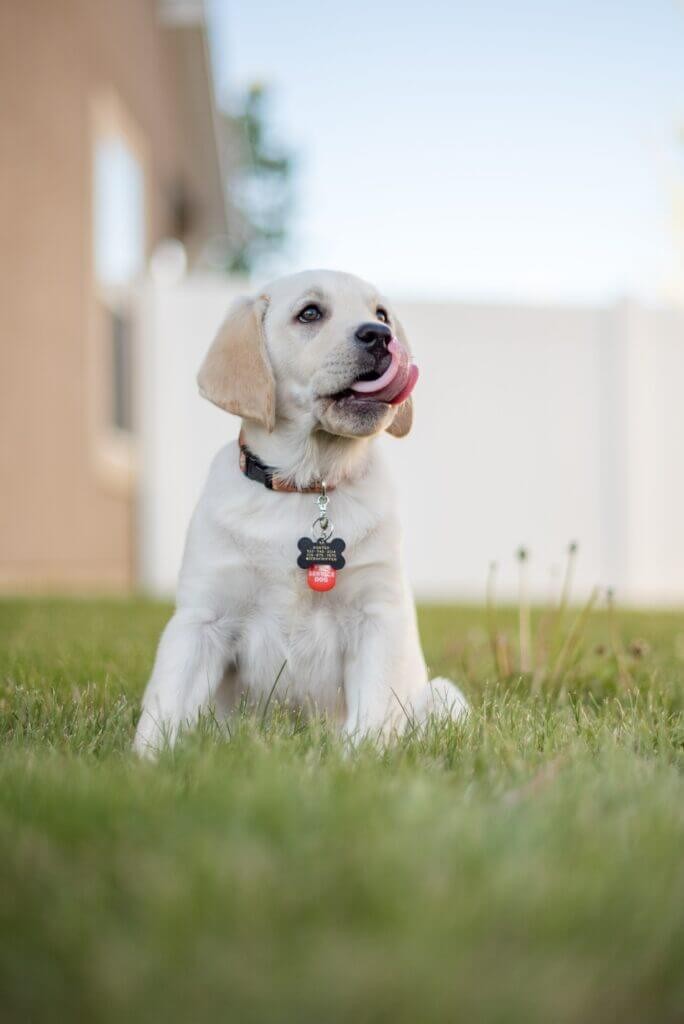Have you ever wondered, “Why Does My Dog Lick My Hands?” It’s a common behavior among our canine companions, and while some of us find it endearing, others might find it a bit… slobbery. Here at why.edu.vn, we understand your curiosity about your furry friend’s actions. Let’s dive into the fascinating world of dog behavior and explore the various reasons behind this common canine quirk.
Do you have a dog that’s a hand-licking enthusiast? In this comprehensive guide, we’ll unravel the mystery behind why dogs lick hands. We’ll explore a range of motivations, from showing affection to seeking information. We’ll also discuss whether this behavior is something to encourage or discourage, and provide you with practical training tips to manage hand-licking if you prefer to minimize it.
Understanding your dog’s behavior is key to a happy and harmonious relationship. Just like humans communicate through words, dogs use a variety of body language cues, and licking is one of them. To truly understand your dog, it’s essential to learn their language.
Decoding the Lick: Common Reasons Your Dog Licks Your Hands
While the simple answer might be “because they love you,” the reasons behind your dog’s hand-licking habit are often more nuanced and varied. Here are some of the most common explanations:
Affection and Bonding: Canine Kisses of Love
One of the most heartwarming reasons your dog licks your hands is to express affection. Licking is a natural social behavior for dogs. They often lick each other as a sign of bonding and care. When your dog licks you, they are extending this same affectionate behavior to you, their beloved human. It’s their way of saying, “I love you,” in dog language. This type of licking is often gentle and accompanied by other signs of affection, like a wagging tail and soft eyes. If you’ve been feeling down, you might notice your dog licking your hands more. This could be their way of comforting you, showcasing their incredible empathy and emotional intelligence.
Greeting and Social Interaction: “Hello There!”
A quick lick to the hand can be your dog’s way of greeting you, especially after you’ve been away. Think of it as their version of a handshake or a friendly “hello.” This greeting lick is usually brief and often accompanied by other excited behaviors like tail wagging, a bouncy posture, and maybe even a little jump. They are simply overjoyed at your return and are expressing their happiness through a lick. This is especially common when you arrive home after being out, as they’ve missed you and are thrilled to have you back.
Communication and Needs: A Gentle Nudge
Dogs are masters of non-verbal communication. Since they can’t talk to us in words, they use other methods to convey their needs and desires. Licking your hands can be one of these communication attempts. They might be trying to tell you they are hungry, thirsty, need to go outside to potty, or want your attention for playtime. Pay attention to the context of the licking. Is it happening around meal times? After they’ve been sleeping for a long time and might need a bathroom break? Observing the timing and accompanying behaviors can help you decipher what your dog is trying to communicate.
Stress and Anxiety Relief: Seeking Comfort
Sometimes, excessive hand-licking can be a sign of stress or anxiety in dogs. Licking is a self-soothing behavior for them, releasing endorphins that have a calming effect. If your dog is feeling nervous, anxious, or overwhelmed, they might resort to licking your hands (or themselves, or objects) as a way to cope. This type of licking is often more persistent and repetitive than affectionate licking. Look for other signs of stress, such as panting, pacing, yawning, lip licking (without food present), or a tucked tail. Identifying and addressing the source of their stress is crucial if you suspect anxiety-related licking. Fear periods, common during puppyhood and adolescence, can also trigger anxiety-related licking.
Pain Relief: A Self-Soothing Mechanism
Similar to stress-related licking, dogs might lick their hands (or your hands) when they are experiencing pain or discomfort. Licking can provide a temporary distraction from pain and release endorphins, acting as a natural pain reliever. If your dog suddenly starts licking your hands excessively and doesn’t usually do so, consider if they might be injured or in pain. Check for any visible signs of injury and consult with a veterinarian if you suspect pain is the reason behind the licking.
Exploring Scents and Tastes: The World Through Smell and Taste
Dogs have an incredible sense of smell and taste. Your hands, being exposed to the world, carry a multitude of interesting scents and even subtle tastes. If you’ve recently handled food, especially something appealing to dogs, or touched another animal, your hands will be incredibly interesting to your dog’s sensitive nose and tongue. They are essentially “investigating” the world through your hands, gathering information about where you’ve been and what you’ve been doing. This exploratory licking is driven by their natural curiosity and their reliance on scent and taste to understand their environment.
Delicious Residue: A Taste of You (or Your Snacks!)
Let’s be honest, sometimes your dog is licking your hands simply because they taste good! If you’ve been eating, especially something salty, savory, or sweet, there might be tasty residue left on your hands that your dog finds irresistible. Dogs are natural scavengers, and they are always on the lookout for a tasty morsel. A lick of your hand after you’ve been enjoying a snack is just a convenient way for them to see if they can get a little taste too!
Is Dog Hand Licking a Bad Habit?
Whether dog hand-licking is “bad” is subjective and depends on the context and your personal preferences. From a behavioral standpoint, licking is a natural canine behavior and often serves important communication and bonding purposes. However, from a human perspective, excessive or unwanted licking can be bothersome or even unhygienic.
Consider the type of licking. Affectionate licks are generally harmless and can be seen as a positive sign of your bond with your dog. However, if the licking is obsessive, persistent, or seems to be linked to stress or anxiety, it might be indicative of an underlying issue that needs to be addressed.
Ultimately, whether you allow or discourage hand-licking is a personal choice.
Should You Let Your Dog Lick Your Hands?
In most cases, allowing your dog to lick your hands is perfectly fine. It’s a natural behavior, and as we’ve discussed, it can be a sign of affection, greeting, or communication. If you enjoy the “kisses” from your dog and don’t find it bothersome, there’s usually no need to stop it.
However, there are situations where you might want to discourage or manage hand-licking:
- Hygiene Concerns: If you are concerned about hygiene, especially before preparing food or if you have open wounds on your hands, you might want to limit hand-licking. Remember, dogs explore the world with their mouths, so their mouths can harbor bacteria.
- Excessive Licking: If the licking becomes excessive, persistent, or seems to be driven by anxiety or stress, it’s important to address the underlying cause and potentially redirect the behavior.
- Personal Preference: Some people simply don’t enjoy the sensation of dog licks. If you fall into this category, it’s perfectly valid to train your dog to offer alternative behaviors.
How to Discourage Dog Hand Licking: Training Tips
If you’ve decided you want to reduce or stop your dog from licking your hands, here’s a step-by-step approach using positive reinforcement training:
1. Identify the Reason Behind the Licking
Before you start training, try to understand why your dog is licking your hands. Is it for affection, greeting, attention-seeking, stress, or taste? Understanding the motivation will help you tailor your training approach. If you suspect stress or anxiety, consulting a certified dog behaviorist is recommended.
2. Provide Alternative Licking Outlets
Dogs have a natural urge to lick and chew. Provide them with appropriate outlets for these behaviors. Offer chew toys, puzzle toys like Kongs filled with treats, or lick mats. These can redirect their licking drive to more appropriate objects.
3. Redirection and Distraction
When your dog starts to lick your hands, gently redirect their attention to a toy or a different activity. Offer them a favorite toy and engage in a quick play session. This redirects their focus away from licking your hands and onto something more desirable.
4. Teach Alternative Behaviors
Train your dog to perform alternative behaviors instead of licking your hands. For example, teach them to “sit” or “shake hands” as a greeting. When you come home, instead of letting them lick your hands, cue them to “sit” and reward them with praise and a treat when they comply. Positive reinforcement is key – reward the behaviors you want to see.
5. Withdraw Attention
If your dog is licking your hands for attention, and you want to discourage it, try calmly withdrawing attention. If they start licking, gently remove your hands, turn away, and avoid eye contact. Only give them attention again when they stop licking. This teaches them that licking your hands doesn’t get them the attention they seek.
6. Management: Make Your Hands Less Accessible
Sometimes, simply managing the situation can be effective. If you know your dog tends to lick your hands when you are relaxing on the couch, keep your hands occupied with a book or your phone. If they can’t easily access your hands, they are less likely to lick them.
Consistent training and positive reinforcement are crucial for success. Be patient and understanding with your dog, and celebrate small victories along the way.
Understanding why your dog licks your hands empowers you to respond appropriately to this behavior. Whether you embrace the canine kisses or prefer to redirect them, knowing the reasons behind it strengthens your bond with your furry companion and ensures a happier, healthier relationship. Exploring further into canine body language can provide even deeper insights into how your dog communicates and perceives the world around them.

